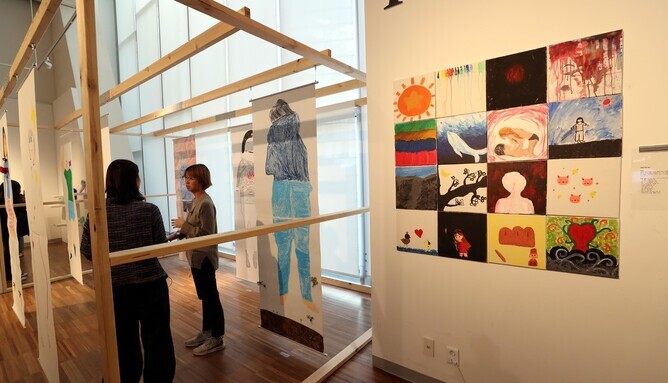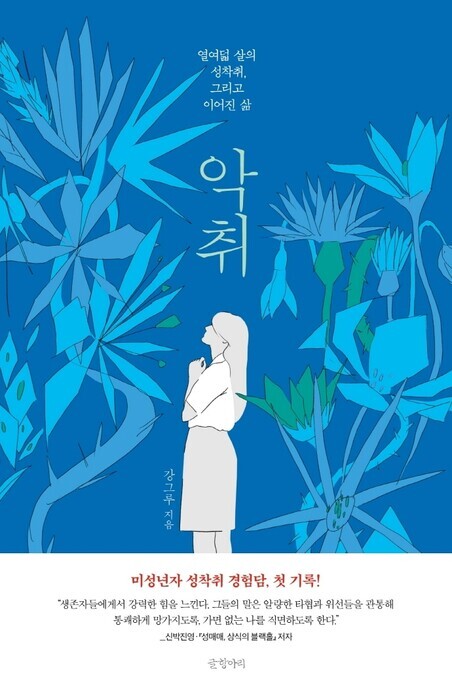hankyoreh
Links to other country sites 다른 나라 사이트 링크
[Book review] “The Stench: Sexual Exploitation at the Age of 18 and the Life That Followed”

Everyone inhabits their own reality. We may all live in the same world, but the world treats you, me, and others in a myriad of ways. Some perceive disparities in real estate values or salaries, while others are pained by each person’s distinct position in relation to sexual violence: some as perpetrators, some as victims, and some as onlookers.
The subtitle of Kang Geu-ru’s book “The Stench” — “Sexual Exploitation at the Age of 18 and the Life That Followed” — illustrates the reality of the sexual exploitation that the author suffered as a minor. Many people use smartphones, but what they see varies depends on the apps they use and the moment when a given photo was taken. It was at the age of 18 that Kang learned the price she would pay for the compliments, interest, and attention she’d received from others.
Kang’s story began with looking for part-time work. She needed money to pay for classes that would help her acquire certain qualifications, so she posted her profile on a part-time job board online. She also searched the board for jobs that looked feasible.
The businesses that Kang contacted turned her down, explaining she couldn’t work without permission from her parents. The businesses that contacted her sent messages of the following sort: “You can make 30,000 won (US$26.4) if you go on an hour-long date with older boys in college. If you need more money, you can get 20,000 won (US$17.6) more for getting physical and 70,000 won (US$61.6) more for spending the night together.”
She said she wasn’t interested and deleted those text messages. But the more trouble she had finding work, the more she thought about being paid 30,000 won to just go on a date.
Kang got another text message from the business. Her friends did everything they could to stop her, but she figured it would be OK.

The man asked her to wear a skirt, since she was going on a date. Her school uniform would be fine, he said.
“I didn’t know at that time that a school uniform could be a shield for some people but a target for others,” she wrote.
Kang’s first date ended with a short drive, and she got paid. The man texted her occasionally about everyday things.”
“I found out that adults who sexually exploit minors deliberately send a few text messages like that so that they can later claim they were in a romantic relationship if they get reported.”
The man kept in contact, they kept meeting, and they gradually got into a physical relationship.
Kang was paid 50,000 won (US$44) if she let the man touch her. When the man climbed on top of her and masturbated, she was even more shocked than when she’d been molested in elementary school. But she “didn’t think that would have any impact on [her].”
Despite feeling that her previous self had disappeared, she realized she liked having some money in her life. When she went shopping with her friends, she could buy what she wanted without counting pennies.
In just a month, she’d reached the point where the man wanted to have sex. After getting out of the man’s car, she stood there on the street for a while. She comforted herself with the thought that, since it was the middle of winter and she was wearing a black windbreaker, anyone who happened to see her would probably mistake her for a trash can.
After two months, she no longer even pretended she was trying to please the man.
Next, Kang learned about the existence of random chatting apps. She chatted with women her age who were paid to have sex. During these chats, she learned about the objects and actions involved, and also about how much money she could charge.
Kang also had a chance to talk about her own situation. One man who’d been listening to her story gave her his phone number and suggested they meet up. He offered to pay her 100,000 (US$88) won, which was double what she was getting from the man she was seeing at the time.
She only told her close friends about part of what was happening. Her stories (and the omissions) went like this. “Still, he takes me out for a nice meal (and we have sex), he takes me for a drive (and we have sex), and he listens to me (and then we have sex). I don’t like the physical stuff very much, but aside from that, he’s good to me (because he wants to have sex with a minor).”
Now, she knows that while her eyes were closed during sex, she was being filmed. She wonders how she could have been so blind.
After she stopped having sex with the two men, she visited a site containing illegal pornography and browsed through the photos “to find [her]self.” There were various school-age girls there in school uniforms. Some of the posts listed the area, the school, the grade, and even the name of these girls.
Kang submitted her university applications and then got a part-time job serving at a restaurant. After she was paid, she pondered how naive she had been to sell herself for such a small amount of money.
Prostitution is a transaction between two individuals, yet it’s often women that people take issue with. Illegally recorded images don’t show the face of the person who took them. Surely few would argue that a minor and an adult ought to share responsibility equally.
In the book, Kang says she first learned that there were people and organizations who help sexually exploited minors after hearing about “Today,” an exhibition focusing on those minors. She recalled how, on a visit to the exhibition, she broke into tears when she saw a sticky note that said, “It’s not your fault.”
Kang went on: “I’d truly never once thought of myself as a victim because of the money and pleasure I’d received. That made it even harder. The confusing thing was that, legally speaking, we were guilty of the same crime, but I was acting like a victim.”
But were they really guilty of the same crime? Are minors and adults capable of the same level of cognition, judgment, and responsibility?
In the book, Kang wrote that adult men approach minors because they want “real” high school students in school uniforms — as she put it, “real girls wearing real uniforms from middle schools and high schools.” That interest is connected to the market for illegally recorded materials.
This book, which is written in the first person, testifies that accepting one’s own victimhood is the process not of losing oneself but of finding it. When the 28-year-old writer looks back on her 18-year-old self, she sometimes uses the language of reproach, but while writing about the men who solicited sex from a minor, she clearly recognizes her own vulnerability as a minor.
As Shin-Park Jin-yeong, the head of policy for National Solidarity Against Sexual Exploitation of Women, wrote in the foreword to Kang’s book, there’s no reason to take on the stench of those who attempt to exploit our weakness, mistakes, and failures.
The book is dedicated to “my past self, at the age of 18, and to the children and adults who have experienced the same things as me.” In the spirit of that dedication, I hope that “The Stench” will save people from their present circumstances.
By Lee Da-hye, Cine 21 writer
Please direct comments or questions to [english@hani.co.kr]

Editorial・opinion
![[Editorial] Yoon must halt procurement of SM-3 interceptor missiles [Editorial] Yoon must halt procurement of SM-3 interceptor missiles](https://flexible.img.hani.co.kr/flexible/normal/500/300/imgdb/child/2024/0501/17145495551605_1717145495195344.jpg) [Editorial] Yoon must halt procurement of SM-3 interceptor missiles
[Editorial] Yoon must halt procurement of SM-3 interceptor missiles![[Guest essay] Maybe Korea’s rapid population decline is an opportunity, not a crisis [Guest essay] Maybe Korea’s rapid population decline is an opportunity, not a crisis](https://flexible.img.hani.co.kr/flexible/normal/500/300/imgdb/original/2024/0430/9417144634983596.jpg) [Guest essay] Maybe Korea’s rapid population decline is an opportunity, not a crisis
[Guest essay] Maybe Korea’s rapid population decline is an opportunity, not a crisis- [Column] Can Yoon steer diplomacy with Russia, China back on track?
- [Column] Season 2 of special prosecutor probe may be coming to Korea soon
- [Column] Park Geun-hye déjà vu in Yoon Suk-yeol
- [Editorial] New weight of N. Korea’s nuclear threats makes dialogue all the more urgent
- [Guest essay] The real reason Korea’s new right wants to dub Rhee a founding father
- [Column] ‘Choson’: Is it time we start referring to N. Korea in its own terms?
- [Editorial] Japan’s rewriting of history with Korea has gone too far
- [Column] The president’s questionable capacity for dialogue
Most viewed articles
- 1Months and months of overdue wages are pushing migrant workers in Korea into debt
- 2Trump asks why US would defend Korea, hints at hiking Seoul’s defense cost burden
- 3At heart of West’s handwringing over Chinese ‘overcapacity,’ a battle to lead key future industries
- 4[Editorial] Yoon must halt procurement of SM-3 interceptor missiles
- 5[Guest essay] Maybe Korea’s rapid population decline is an opportunity, not a crisis
- 6Fruitless Yoon-Lee summit inflames partisan tensions in Korea
- 7Dermatology, plastic surgery drove record medical tourism to Korea in 2023
- 8First meeting between Yoon, Lee in 2 years ends without compromise or agreement
- 91 in 3 S. Korean security experts support nuclear armament, CSIS finds
- 10AI is catching up with humans at a ‘shocking’ rate